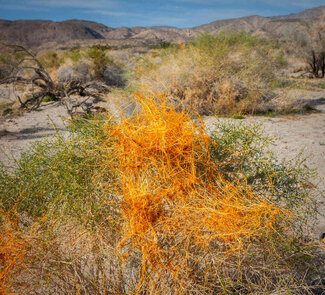Nature Watch: "Dodder"
Last updated 2/15/2024 at 10:26am
Wandering through a desert wash recently, there were several shrubs that looked like they had been covered by thick strands of orange string.
This yellow to orange material is actually a parasite plant known as desert dodder, a native to the deserts of the Southwest. Worldwide, there are over 150 species of this interesting plant.
Its hair-like appearance has resulted in the plant having many names, including witch's hair, devil's hair, angel hair, goldthread, and lady's laces.
An annual plant that grows well in warm climates, dodder has an interesting life cycle that begins with seeds that germinate underground when moisture and temperatures are ideal. Seeds can lay dormant for 20 years or more until conditions are right.
But as it begins to grown, dodder has no root system that will allow it to take up water or nutrients and within five to ten days it must attach itself to a host plant where it will root into the host and extract food and water and grow until it produces seeds and then dies at the end of the growing season.
To locate the suitable host, the seedlings emerge and swirl around until they find a plant that will provide food and moisture.
Like many parasites, dodder does not kill the host plant, however a heavy infestation from multiple dodder plants can eventually kill host plants.
Dodder appears leafless but does have small scale-like leaves.
It will bloom during its growing season, producing tiny, bell-shaped white flowers.
Seeds are contained in small capsules about the size of a pinhead.
While the host plant receives no benefit from this parasite, dodder does host the brown elfin moth.

Contact Ernie @ Packtrain.com or follow http://erniesoutdoors.blogspot.com/



